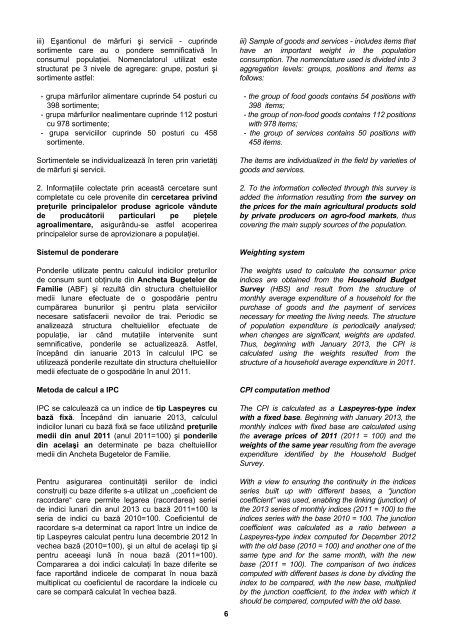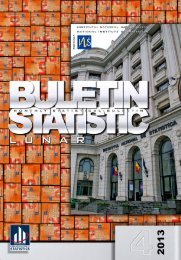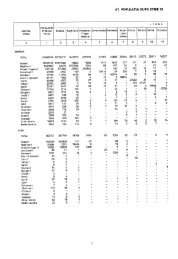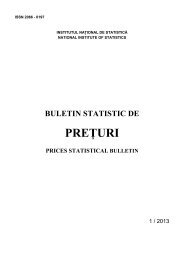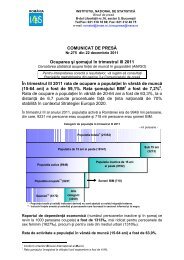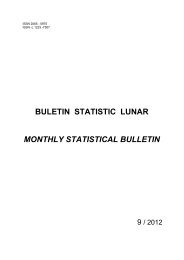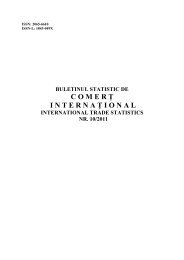buletin statistic de preţuri prices statistical bulletin - Institutul National ...
buletin statistic de preţuri prices statistical bulletin - Institutul National ...
buletin statistic de preţuri prices statistical bulletin - Institutul National ...
Create successful ePaper yourself
Turn your PDF publications into a flip-book with our unique Google optimized e-Paper software.
iii) Eşantionul <strong>de</strong> mărfuri şi servicii - cuprin<strong>de</strong>sortimente care au o pon<strong>de</strong>re semnificativă înconsumul populaţiei. Nomenclatorul utilizat estestructurat pe 3 nivele <strong>de</strong> agregare: grupe, posturi şisortimente astfel:- grupa mărfurilor alimentare cuprin<strong>de</strong> 54 posturi cu398 sortimente;- grupa mărfurilor nealimentare cuprin<strong>de</strong> 112 posturicu 978 sortimente;- grupa serviciilor cuprin<strong>de</strong> 50 posturi cu 458sortimente.Sortimentele se individualizează în teren prin varietăţi<strong>de</strong> mărfuri şi servicii.2. Informaţiile colectate prin această cercetare suntcompletate cu cele provenite din cercetarea privindpreţurile principalelor produse agricole vândute<strong>de</strong> producătorii particulari pe pieţeleagroalimentare, asigurându-se astfel acoperireaprincipalelor surse <strong>de</strong> aprovizionare a populaţiei.Sistemul <strong>de</strong> pon<strong>de</strong>rarePon<strong>de</strong>rile utilizate pentru calculul indicilor preţurilor<strong>de</strong> consum sunt obţinute din Ancheta Bugetelor <strong>de</strong>Familie (ABF) şi rezultă din structura cheltuielilormedii lunare efectuate <strong>de</strong> o gospodărie pentrucumpărarea bunurilor şi pentru plata serviciilornecesare satisfacerii nevoilor <strong>de</strong> trai. Periodic seanalizează structura cheltuielilor efectuate <strong>de</strong>populaţie, iar când mutaţiile intervenite suntsemnificative, pon<strong>de</strong>rile se actualizează. Astfel,începând din ianuarie 2013 în calculul IPC seutilizează pon<strong>de</strong>rile rezultate din structura cheltuielilormedii efectuate <strong>de</strong> o gospodărie în anul 2011.Metoda <strong>de</strong> calcul a IPCIPC se calculează ca un indice <strong>de</strong> tip Laspeyres cubază fixă. Începând din ianuarie 2013, calcululindicilor lunari cu bază fixă se face utilizând preţurilemedii din anul 2011 (anul 2011=100) şi pon<strong>de</strong>riledin acelaşi an <strong>de</strong>terminate pe baza cheltuielilormedii din Ancheta Bugetelor <strong>de</strong> Familie.Pentru asigurarea continuităţii seriilor <strong>de</strong> indiciconstruiţi cu baze diferite s-a utilizat un „coeficient <strong>de</strong>racordare“ care permite legarea (racordarea) seriei<strong>de</strong> indici lunari din anul 2013 cu bază 2011=100 laseria <strong>de</strong> indici cu bază 2010=100. Coeficientul <strong>de</strong>racordare s-a <strong>de</strong>terminat ca raport între un indice <strong>de</strong>tip Laspeyres calculat pentru luna <strong>de</strong>cembrie 2012 învechea bază (2010=100), şi un altul <strong>de</strong> acelaşi tip şipentru aceeaşi lună în noua bază (2011=100).Compararea a doi indici calculaţi în baze diferite seface raportând indicele <strong>de</strong> comparat în noua bazămultiplicat cu coeficientul <strong>de</strong> racordare la indicele cucare se compară calculat în vechea bază.6iii) Sample of goods and services - inclu<strong>de</strong>s items thathave an important weight in the populationconsumption. The nomenclature used is divi<strong>de</strong>d into 3aggregation levels: groups, positions and items asfollows:- the group of food goods contains 54 positions with398 items;- the group of non-food goods contains 112 positionswith 978 items;- the group of services contains 50 positions with458 items.The items are individualized in the field by varieties ofgoods and services.2. To the information collected through this survey isad<strong>de</strong>d the information resulting from the survey onthe <strong>prices</strong> for the main agricultural products soldby private producers on agro-food markets, thuscovering the main supply sources of the population.Weighting systemThe weights used to calculate the consumer priceindices are obtained from the Household BudgetSurvey (HBS) and result from the structure ofmonthly average expenditure of a household for thepurchase of goods and the payment of servicesnecessary for meeting the living needs. The structureof population expenditure is periodically analysed;when changes are significant, weights are updated.Thus, beginning with January 2013, the CPI iscalculated using the weights resulted from thestructure of a household average expenditure in 2011.CPI computation methodThe CPI is calculated as a Laspeyres-type in<strong>de</strong>xwith a fixed base. Beginning with January 2013, themonthly indices with fixed base are calculated usingthe average <strong>prices</strong> of 2011 (2011 = 100) and theweights of the same year resulting from the averageexpenditure i<strong>de</strong>ntified by the Household BudgetSurvey.With a view to ensuring the continuity in the indicesseries built up with different bases, a “junctioncoefficient” was used, enabling the linking (junction) ofthe 2013 series of monthly indices (2011 = 100) to theindices series with the base 2010 = 100. The junctioncoefficient was calculated as a ratio between aLaspeyres-type in<strong>de</strong>x computed for December 2012with the old base (2010 = 100) and another one of thesame type and for the same month, with the newbase (2011 = 100). The comparison of two indicescomputed with different bases is done by dividing thein<strong>de</strong>x to be compared, with the new base, multipliedby the junction coefficient, to the in<strong>de</strong>x with which itshould be compared, computed with the old base.


